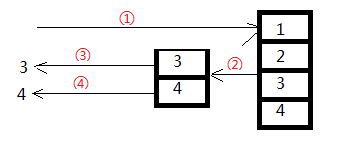C# yield return用法
阿新 • • 發佈:2017-09-03
理解 ring ref 所有 每次 () r12 停止 image
本文實例講述了C#中yield return用法,並且對比了使用yield return與不使用yield return的情況,以便讀者更好的進行理解。具體如下:
yield關鍵字用於遍歷循環中,yield return用於返回IEnumerable<T>,yield break用於終止循環遍歷。
有這樣的一個int類型的集合:
?| 1 2 3 4 |
static List<int> GetInitialData()
{
return new List<int>(){1,2,3,4};
}
|
需要打印出所有值大於2的元素。
不使用yield return的實現
?| 1 2 3 4 5 6 7 8 9 10 11 12 |
static IEnumerable<int> FilterWithoutYield()
{
List<int> result = new List<int>();
foreach (int i in GetInitialData())
{
if (i > 2)
{
result.Add(i);
}
}
return result;
}
|
客戶端調用:
?| 1 2 3 4 5 6 7 8 |
static void Main(string[] args)
{
foreach (var item in FilterWithoutYield())
{
Console.WriteLine(item);
}
Console.ReadKey();
}
|
輸出結果:3,4
使用yeild return實現
?| 1 2 3 4 5 6 7 8 9 10 11 12 |
static IEnumerable<int> FilterWithYield()
{
foreach (int i in GetInitialData())
{
if (i > 2)
{
yield return i;
}
}
yield break;
Console.WriteLine("這裏的代碼不執行");
}
|
客戶端調用:
?| 1 2 3 4 5 6 7 8 |
static void Main(string[] args)
{
foreach (var item in FilterWithYield())
{
Console.WriteLine(item);
}
Console.ReadKey();
}
|
輸出結果:3,4
總結:
通過單步調試發現:
雖然2種方法的輸出結果是一樣的,但運作過程迥然不同。第一種方法,是把結果集全部加載到內存中再遍歷;第二種方法,客戶端每調用一次,yield return就返回一個值給客戶端,是"按需供給"。
第一種方法,客戶端調用過程大致為:

使用yield return,客戶端調用過程大致為:

使用yield return為什麽能保證每次循環遍歷的時候從前一次停止的地方開始執行呢?
--因為,編譯器會生成一個狀態機來維護叠代器的狀態。
簡單地說,當希望獲取一個IEnumerable<T>類型的集合,而不想把數據一次性加載到內存,就可以考慮使用yield return實現"按需供給"。
希望本文所述對大家的C#程序設計有所幫助。
C# yield return用法
